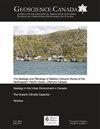Classic Rock Tours 1. Hutton’s Unconformity at Siccar Point, Scotland: A Guide for Visiting the Shrine on the Abyss of Time
IF 0.8
4区 地球科学
Q3 GEOSCIENCES, MULTIDISCIPLINARY
引用次数: 2
Abstract
The angular unconformity at Siccar Point in Scotland is one of the most famous localities in the history of geology. At this spot, steeply dipping, folded turbiditic sandstone of early Silurian age is clearly overlain by subhorizontal red conglomerate, breccia and sandstone of late Devonian age. Siccar Point was not the first unconformity ever to be described or illustrated, but it is unquestionably one of the most spectacular and informative that geologists are likely to see. In June of 1788, a famous excursion by James Hutton, John Playfair and Sir James Hall first discovered this striking evidence for the cyclic nature of geological processes and the probable antiquity of the Earth. Contrary to myth, it was likely not the inspiration for Hutton’s famous phrase no vestige of a beginning, no prospect of an end, but Playfair’s metaphor of looking so far into the abyss of time is forever associated with this place. Siccar Point influenced many other geologists, including the young Charles Lyell, who would eventually bring the ideas of James Hutton together with those of William Smith, to build the uniformitarian paradigm that founded modern geology. Lyell’s writings would in turn influence the young Charles Darwin in his search for the reality and causes of evolution. Siccar Point is easy to visit from the historic and vibrant city of Edinburgh, and such a pilgrimage is easily combined with other sights of geological or cultural interest. Visiting the shrine involves a short coastal hike in one of the most beautiful parts of Scotland. This article combines practical advice for would-be pilgrims to Siccar Point with some historical context about its pivotal role in the development of geological ideas in the enlightenment of the late 18th and early 19th centuries.RESUMELa discordance angulaire de Siccar Point en Ecosse est l'une des localites les plus celebres de l'histoire de la geologie. A cet endroit, un gres turbiditique plisse a fort pendage du debut du Silurien est recouvert de conglomerats rouges subhorizontaux, de breches et d’un gres de la fin du Devonien. Siccar Point n'est pas la premiere discordance qui ait ete decrite ou illustree, mais c'est sans conteste l'une des plus spectaculaires et revelatrices que les geologues puissent voir. En juin 1788, avec leur celebre excursion, James Hutton, John Playfair et Sir James Hall ont decouvert cette preuve frappante de la nature cyclique des processus geologiques et de l`anciennete probable de la Terre. Contrairement a ce qu'on croit, ce n'est probablement pas la fameuse phrase de Hutton « aucun vestige d'un debut, aucune perspective de fin », mais la metaphore de Playfair « voir si loin dans l'abime du temps » qui est a jamais associee a ce lieu. Siccar Point a influence de nombreux autres geologues, y compris le jeune Charles Lyell, qui a fini par reunir les idees de James Hutton et celles de William Smith qui ont defini le paradigme uniformitariste, devenu le fondement de la geologie moderne. Les ecrits de Lyell influenceront a leur tour le jeune Charles Darwin dans sa recherche de la realite et des causes de l'evolution. Il est facile de se rendre a Siccar Point depuis cette ville chargee d'histoire et dynamique qu’est Edimbourg, et un tel pelerinage se combine facilement avec d'autres sites d'interet geologique ou culturel. La visite de ce « sanctuaire » implique une courte randonnee cotiere dans l'une des plus belles regions d'Ecosse. Le present article combine des conseils pratiques pour les visiteurs potentiels a Siccar Point et presente un historique de son role central dans le developpement des idees geologiques a la fin du XVIIIe siecle et au debut du XIXe siecle.经典摇滚之旅1。Hutton在苏格兰Siccar Point的不整合:时间深渊上的神殿参观指南
苏格兰Siccar点的角度不一致性是地质史上最著名的地方之一。在这一点上,早期志留纪陡峭的浸没、折叠浊砂岩明显被亚水平红色砾岩、Breccia和晚期德文尼亚砂岩覆盖。SICCAR Point并不是第一个被描述或说明的不一致性,但毫无疑问,它是地质学家可能看到的最壮观和信息最丰富的一个。1788年6月,詹姆斯·赫顿、约翰·普莱费尔和詹姆斯·霍尔爵士的一次著名旅行首次发现了地质过程循环性质和地球可能古代的惊人证据。与神话相反,这可能不是赫顿著名短语的灵感,没有开始的痕迹,也没有结束的前景,但Playfair对时间深渊的隐喻永远与这个地方联系在一起。Siccar Point影响了许多其他地质学家,包括年轻的查尔斯·莱尔(Charles Lyell),他最终将詹姆斯·赫顿(James Hutton)的想法与威廉·史密斯(William Smith)的想法结合起来,构建了现代地质学的统一范式。莱尔的作品反过来会影响年轻的查尔斯·达尔文寻找进化的现实和原因。从历史悠久、充满活力的爱丁堡市很容易参观Siccar Point,这样的朝圣很容易与其他地质或文化景点相结合。参观神社涉及苏格兰最美丽的地区之一的短海岸徒步旅行。本文结合了对朝圣者的实用建议和一些历史背景,说明了其在18世纪末和19世纪初启蒙时期地质思想发展中的关键作用。苏格兰Siccar Point的角不和谐是地质史上最著名的地方之一。在这一点上,志留纪早期陡峭倾斜的浑浊褶皱GRES被亚水平红色砾岩、裂缝和德文尼亚晚期GRES覆盖。Siccar Point并不是第一个被描述或说明的差异,但它无疑是地质学家所能看到的最壮观和最具启发性的差异之一。1788年6月,詹姆斯·赫顿(James Hutton)、约翰·普莱费尔(John Playfair)和詹姆斯·霍尔爵士(Sir James Hall)在他们著名的旅行中发现了地质过程周期性和地球可能古老性的惊人证据。与人们所相信的相反,可能不是赫顿的名言“没有开始的痕迹,没有结束的前景”,而是Playfair的隐喻“在时间的深渊中看得那么远”,这句话从未与这个地方联系在一起。Siccar Point影响了许多其他地质学家,包括年轻的查尔斯·莱尔(Charles Lyell),他最终融合了詹姆斯·赫顿(James Hutton)和威廉·史密斯(William Smith)的观点,后者定义了统一主义范式,成为现代地质学的基础。莱尔的著作反过来影响了年轻的查尔斯·达尔文对进化的现实和原因的探索。从爱丁堡这座充满历史和活力的城市很容易到达Siccar Point,这样的朝圣很容易与其他地质或文化景点相结合。参观这个“圣殿”包括在苏格兰最美丽的地区之一进行短暂的海岸徒步旅行。本文结合了对Siccar Point潜在游客的实用建议,并介绍了其在18世纪末和19世纪初地质思想发展中的核心作用的历史。
本文章由计算机程序翻译,如有差异,请以英文原文为准。
求助全文
约1分钟内获得全文
求助全文
来源期刊

Geoscience Canada
地学-地球科学综合
CiteScore
3.30
自引率
0.00%
发文量
9
审稿时长
>12 weeks
期刊介绍:
Established in 1974, Geoscience Canada is the main technical publication of the Geological Association of Canada (GAC). We are a quarterly journal that emphasizes diversity of material, and also the presentation of informative technical articles that can be understood not only by specialist research workers, but by non-specialists in other branches of the Earth Sciences. We aim to be a journal that you want to read, and which will leave you better informed, rather than more confused.
 求助内容:
求助内容: 应助结果提醒方式:
应助结果提醒方式:


